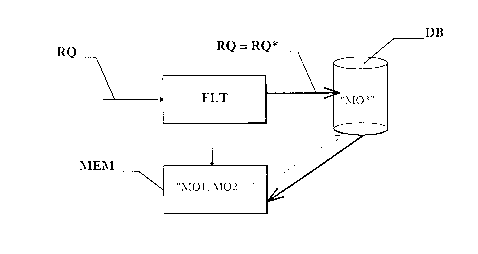Some of the information on this Web page has been provided by external sources. The Government of Canada is not responsible for the accuracy, reliability or currency of the information supplied by external sources. Users wishing to rely upon this information should consult directly with the source of the information. Content provided by external sources is not subject to official languages, privacy and accessibility requirements.
Any discrepancies in the text and image of the Claims and Abstract are due to differing posting times. Text of the Claims and Abstract are posted:
| (12) Patent Application: | (11) CA 2274198 |
|---|---|
| (54) English Title: | MANAGEMENT OF A NETWORK ELEMENT USING MANAGED OBJECTS IN A DIGITAL COMMUNICATIONS NETWORK |
| (54) French Title: | GESTION D'UN COMPOSANT DE RESEAU UTILISANT DES OBJETS DE GESTION DANS UN RESEAU DE COMMUNICATIONS NUMERIQUES |
| Status: | Deemed Abandoned and Beyond the Period of Reinstatement - Pending Response to Notice of Disregarded Communication |
| (51) International Patent Classification (IPC): |
|
|---|---|
| (72) Inventors : |
|
| (73) Owners : |
|
| (71) Applicants : |
|
| (74) Agent: | ROBIC AGENCE PI S.E.C./ROBIC IP AGENCY LP |
| (74) Associate agent: | |
| (45) Issued: | |
| (22) Filed Date: | 1999-06-09 |
| (41) Open to Public Inspection: | 1999-12-12 |
| Availability of licence: | N/A |
| Dedicated to the Public: | N/A |
| (25) Language of filing: | English |
| Patent Cooperation Treaty (PCT): | No |
|---|
| (30) Application Priority Data: | ||||||
|---|---|---|---|---|---|---|
|
Network elements of a digital communications network,
for example of an SDH network (SDH = Synchronous
Digital Hierarchy), are managed by controllers using
managed objects. To permit fast access to managed
objects, a simple circuit with a controller (FLT), a
database (DB), and a temporary memory (MEM) is
proposed. The controller carries out a method of
managing the network element wherein in response to
requests (RQ), the objects are stored into the memory
and individual objects (MO*) are swapped out to make
room for new data according to predeterminal criteria,
which specify, for example, the maximum residence time
of the object in the memory. At least these objects are
transferred to the database (DB). Only upon reception
of a request (RQ*) for access to an object (MO*) which
is no longer in the memory (MEM) will this object (MO*)
be read from the database and transferred back into the
memory. The controller manages the network element in
response to the requests by accessing the memory and
using the objects stored therein.
Note: Claims are shown in the official language in which they were submitted.
Note: Descriptions are shown in the official language in which they were submitted.

2024-08-01:As part of the Next Generation Patents (NGP) transition, the Canadian Patents Database (CPD) now contains a more detailed Event History, which replicates the Event Log of our new back-office solution.
Please note that "Inactive:" events refers to events no longer in use in our new back-office solution.
For a clearer understanding of the status of the application/patent presented on this page, the site Disclaimer , as well as the definitions for Patent , Event History , Maintenance Fee and Payment History should be consulted.
| Description | Date |
|---|---|
| Inactive: IPC expired | 2022-01-01 |
| Inactive: IPC expired | 2022-01-01 |
| Inactive: IPC from PCS | 2022-01-01 |
| Inactive: IPC from MCD | 2006-03-12 |
| Time Limit for Reversal Expired | 2003-06-09 |
| Application Not Reinstated by Deadline | 2003-06-09 |
| Deemed Abandoned - Failure to Respond to Maintenance Fee Notice | 2002-06-10 |
| Inactive: Cover page published | 1999-12-12 |
| Application Published (Open to Public Inspection) | 1999-12-12 |
| Inactive: IPC assigned | 1999-08-02 |
| Inactive: First IPC assigned | 1999-08-02 |
| Inactive: Filing certificate - No RFE (English) | 1999-07-22 |
| Letter Sent | 1999-07-14 |
| Inactive: Filing certificate - No RFE (English) | 1999-07-14 |
| Application Received - Regular National | 1999-07-12 |
| Abandonment Date | Reason | Reinstatement Date |
|---|---|---|
| 2002-06-10 |
The last payment was received on 2001-06-01
Note : If the full payment has not been received on or before the date indicated, a further fee may be required which may be one of the following
Patent fees are adjusted on the 1st of January every year. The amounts above are the current amounts if received by December 31 of the current year.
Please refer to the CIPO
Patent Fees
web page to see all current fee amounts.
| Fee Type | Anniversary Year | Due Date | Paid Date |
|---|---|---|---|
| Registration of a document | 1999-06-09 | ||
| Application fee - standard | 1999-06-09 | ||
| MF (application, 2nd anniv.) - standard | 02 | 2001-06-11 | 2001-06-01 |
Note: Records showing the ownership history in alphabetical order.
| Current Owners on Record |
|---|
| ALCATEL |
| Past Owners on Record |
|---|
| JORG SCHABERNACK |
| MONIKA BANZHAF |